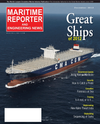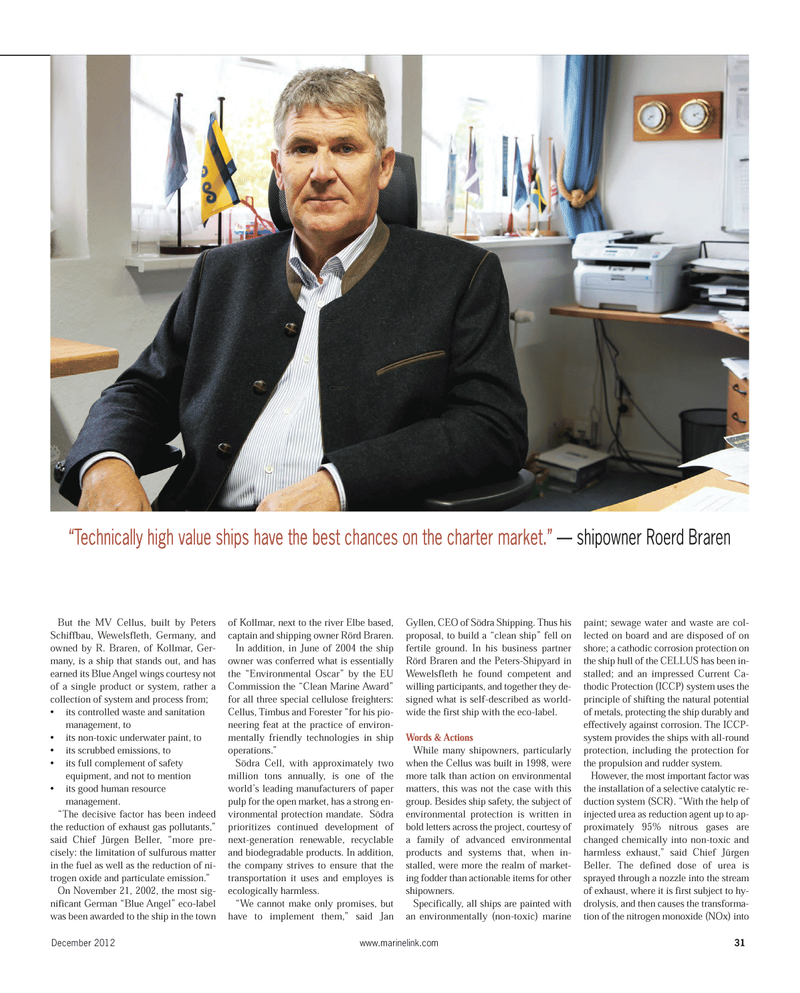
Page 31: of Maritime Reporter Magazine (December 2012)
Great Ships of 2012
Read this page in Pdf, Flash or Html5 edition of December 2012 Maritime Reporter Magazine
December 2012www.marinelink.com 31?Technically high value ships have the best chances on the charter market.? ? shipowner Roerd Braren But the MV Cellus, built by Peters Schiffbau, Wewelsfleth, Germany, and owned by R. Braren, of Kollmar, Ger- many, is a ship that stands out, and has earned its Blue Angel wings courtesy not of a single product or system, rather acollection of system and process from;its controlled waste and sanitation management, to its non-toxic underwater paint, to its scrubbed emissions, to its full complement of safety equipment, and not to mention its good human resource management.?The decisive factor has been indeed the reduction of exhaust gas pollutants,? said Chief Jürgen Beller, ?more pre- cisely: the limitation of sulfurous matterin the fuel as well as the reduction of ni-trogen oxide and particulate emission.? On November 21, 2002, the most sig- nificant German ?Blue Angel? eco-label was been awarded to the ship in the town of Kollmar, next to the river Elbe based, captain and shipping owner Rörd Braren. In addition, in June of 2004 the shipowner was conferred what is essentially the ?Environmental Oscar? by the EU Commission the ?Clean Marine Award? for all three special cellulose freighters:Cellus, Timbus and Forester ?for his pio- neering feat at the practice of environ- mentally friendly technologies in shipoperations.? Södra Cell, with approximately two million tons annually, is one of the world?s leading manufacturers of paper pulp for the open market, has a strong en- vironmental protection mandate. Södraprioritizes continued development of next-generation renewable, recyclable and biodegradable products. In addition, the company strives to ensure that the transportation it uses and employes is ecologically harmless.?We cannot make only promises, but have to implement them,? said Jan Gyllen, CEO of Södra Shipping. Thus his proposal, to build a ?clean ship? fell on fertile ground. In his business partner Rörd Braren and the Peters-Shipyard in Wewelsfleth he found competent and willing participants, and together they de- signed what is self-described as world- wide the first ship with the eco-label. Words & Actions While many shipowners, particularly when the Cellus was built in 1998, were more talk than action on environmental matters, this was not the case with this group. Besides ship safety, the subject of environmental protection is written in bold letters across the project, courtesy ofa family of advanced environmental products and systems that, when in-stalled, were more the realm of market- ing fodder than actionable items for othershipowners. Specifically, all ships are painted with an environmentally (non-toxic) marine paint; sewage water and waste are col- lected on board and are disposed of onshore; a cathodic corrosion protection onthe ship hull of the CELLUS has been in-stalled; and an impressed Current Ca-thodic Protection (ICCP) system uses theprinciple of shifting the natural potentialof metals, protecting the ship durably andeffectively against corrosion. The ICCP- system provides the ships with all-round protection, including the protection forthe propulsion and rudder system. However, the most important factor was the installation of a selective catalytic re- duction system (SCR). ?With the help of injected urea as reduction agent up to ap-proximately 95% nitrous gases are changed chemically into non-toxic andharmless exhaust,? said Chief Jürgen Beller. The defined dose of urea is sprayed through a nozzle into the streamof exhaust, where it is first subject to hy- drolysis, and then causes the transforma- tion of the nitrogen monoxide (NOx) intoMR#12 (26-33):MR Template 12/3/2012 2:27 PM Page 31

 30
30

 32
32
